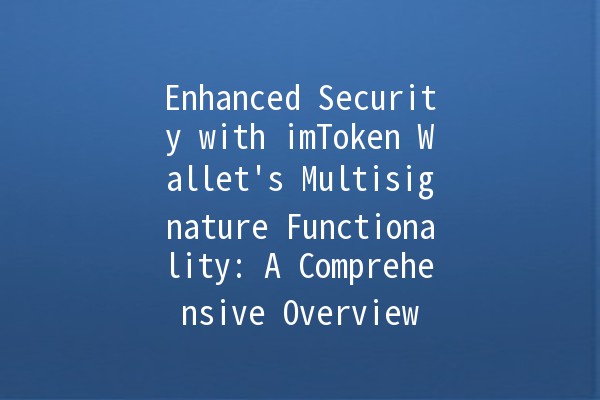In the rapidly evolving world of blockchain technology and digital currencies, securing assets has become a top priority for both individual users and businesses. One of the most effective ways to enhance security within cryptocurrency wallets is the implementation of multisignature functionality. In this article, we will delve into the features and benefits of the multisignature function in imToken Wallet, a popular Ethereum wallet, while providing actionable tips and insights for utilizing this feature effectively.
Multisignature, often abbreviated to "multisig," refers to a digital signature scheme that requires multiple private keys to authorize a transaction. This approach adds an extra layer of security compared to traditional singlesignature wallets, where only one private key is needed. In a multisig wallet, even if one key is compromised, unauthorized access to funds is still prevented, safeguarding the user's assets.

Multisig provides a robust solution against theft and hacking attempts. By requiring multiple signatures from different private keys, it significantly reduces the risk of loss due to a single compromised key.
Multisig wallets are beneficial for organizations or groups that require multiple approvals before a transaction can be executed. This feature ensures accountability and prevents any single individual from having complete control over the wallet.
With multisig functionality, users can set specific rules for how transactions are approved. For example, they can require two out of three signatures for a transaction to be valid, making the approval process more structured and secure.
Start by downloading the imToken Wallet from a legitimate app store or the official website. Ensure that you are using the latest version to take advantage of all available features and security updates.
Once the app is installed:
Navigate to the section for creating a new wallet.
Select 'Multisignature Wallet’ as your wallet type.
Configure the required number of signatures (e.g., 2 out of 3) based on your security needs.
You can invite other users to join the multisig wallet by sharing a generated link or QR code. Each signatory will need to install the imToken Wallet and follow similar steps to ensure they can participate in transaction approvals.
Once you have set up the wallet and added signatories, manage each user’s permissions. Designate roles and thresholds for approvals to ensure smooth transaction reviews.
To harness the full potential of multisignature functionality, consider the following practical tips:
When setting up your multisig wallet, it's crucial to find a balance between security and convenience. A common approach is to require more than half of the signatures for authorization (e.g., 2 out of 3). This configuration allows flexibility while ensuring that no single user holds too much power.
To maintain security, periodically update the private keys associated with your multisig wallet. This practice minimizes the risk of compromised keys and encourages users to maintain their security hygiene.
Ensure that all users participating in the multisig wallet understand the importance of their roles. Educate them on best practices for managing their private keys and recognizing potential phishing attempts, which can often target individuals with access to valuable wallets.
Integrate twofactor authentication into your security protocols, where possible. Although not directly part of the multisig process, 2FA can provide an extra layer of protection against unauthorized access to the wallet’s signatories.
Regularly back up your multisig wallet information. Ensure that all signatories keep a secure copy of their keys and any recovery phrases in a safe location. Having these backups ensures that even in the event of a device loss, funds can still be recovered.
When considering the implementation of multisignature wallets, several misconceptions can deter users. Here are some clarifications:
While setting up a multisignature wallet can seem complex, platforms like imToken have streamlined the process, making it userfriendly for everyone, regardless of technical expertise.
While multisig significantly enhances security, it does not guarantee absolute protection. Users must remain vigilant about their individual security practices to avoid falling victim to hacks or scams.
Not all wallets support multisignature functionality. Therefore, it’s essential to choose a reputable wallet like imToken that explicitly offers this feature.
Multisignature wallets require multiple private keys to execute a transaction, which means that even if one key is compromised, the funds remain secure until the additional keys are also obtained.
Absolutely! You can create a multisig wallet with your own keys configured to require additional keys that you control, offering a secure way to manage your funds.
If a signatory loses their private key, the functionality of the wallet may be impacted, especially if too few keys remain to authorize transactions. It’s important for all signatories to have secure backups of their keys.
Yes, multisig wallets are excellent for businesses requiring team collaboration for fund management. The multisig feature promotes transparency and collective decisionmaking.
Wallet recovery depends on your specific configuration. Each signatory must have their backup keys available. In cases where multiple keys are lost, funds may become inaccessible.
Transaction fees for multisig wallets typically depend on network conditions, the number of signatures required, and other factors. Always check the fees before confirming transactions.
The multisignature function in imToken Wallet represents a robust solution for enhancing the security of cryptocurrency transactions. By implementing effective management strategies and understanding the core principles of multisig technology, users can significantly reduce the risks associated with digital asset management. As the cryptocurrency landscape continues to grow, adopting advanced security measures such as multisignature wallets will be crucial for safeguarding your investments and ensuring peace of mind in an increasingly digital world.